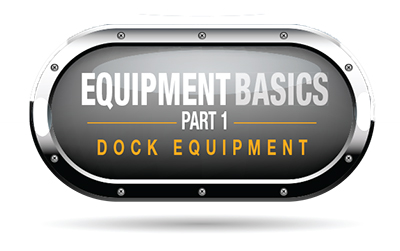The Basics of Warehouse Dock Equipment
The needs for safety, efficiency and detailed data collection are transforming modern docks from mere openings to critical components of an enterprise’s success.
Last year, Modern’s Basics Series explored the functional areas of the warehouse, from receiving to picking and shipping. This year, our Equipment Basics series will focus on equipment segments, beginning with the dock, and followed by conveyors/sortation, automated storage and automatic guided vehicles. In each story, Modern and a group of industry experts will examine the fundamental equipment elements that ensure top performance in the modern warehouse.
Because the standards for performance and safety have changed dramatically in the last decade, “basics” is a relative term. In fact, it might take even less time than that for the descriptions of a modern dock in this article to seem downright old-fashioned. However, for every up-to-date dock there are many, many more that fall short of these basics. Rather than negligence, this is due to the sheer number of docks in use and the rate at which dock technologies have progressed.
The growing toolkit
Walt Swietlik, director of customer relations and sales support at Rite-Hite, remembers “basic” docks as he found them when he joined Rite-Hite 35 years ago. Above a couple of dock bumpers, a typically small, pull-chain style dock leveler sat below a manual overhead door with a basic enclosure. And, that’s about it. If he just described your dock, you might have work to do.
“However, 2018 is considerably different,” Swietlik says. “Now you see push-button dock levelers, typically bigger and with heavier capacities, which have increased by 10,000 to 15,000 pounds. So anyone who used to buy a 20,000-pound capacity is now in the 30,000 to 35,000 range.”
The overhead door—also push-button operated—is now usually bigger than the trailer, which is locked to the dock by a vehicle restraint as opposed to mere chocks or emergency brakes.
“In the 1980s, the industry was in the infancy of getting the message of dock safety off the ground,” Swietlik says. “Now, there’s no question whether there will be a restraint; the question is which kind. Over a 35-year span, there has been a big evolution in size, shape and capacity, but also in terms of the equipment’s operation and level of complexity.”
The modern dock includes interlocks, a series of mechanical and electronic safety measures that prevent anything but the optimal sequence of events. For example, to open the door, the vehicle restraint must first be positively engaged. To operate the leveler, the door must be open. A food, beverage or pharmaceutical company might design its sequence to minimize infiltration of air, dust or critters.
A facility in hot climates might choose this setup simply to conserve air conditioning. On the other hand, managers might like to leave doors open on occasion to get some fresh air, but interlocks will only allow this once after a physical barrier is engaged to prevent people or equipment from falling off the dock. Swietlik says such a barrier should offer a minimum impact rating of 10,000 pounds at 4 mph.
For those customers concerned with securing access to the back of the trailer, energy efficiency and/or sanitation, dock enclosures may be designed to prevent even a sliver of outdoor light from creeping in. Taking it one step further, the interlock sequence might also include a step where photos or videos are captured to verify security and product condition after transit.
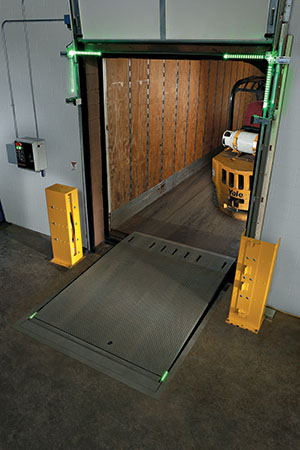 Because dock equipment is increasingly powered by electricity and not elbow grease, the construction of the dock must allow for necessary wiring. Swietlik recommends collaboration between the customer, dock equipment provider and general contractor to ensure all relevant measurements are considered.
Because dock equipment is increasingly powered by electricity and not elbow grease, the construction of the dock must allow for necessary wiring. Swietlik recommends collaboration between the customer, dock equipment provider and general contractor to ensure all relevant measurements are considered.
“You want it to look professional when it’s done, so you don’t want conduit sticking out since someone forgot it when they poured the concrete,” Swietlik says. “It’s all very easy to take care of if it’s addressed early.”
Simply ensuring trailer, door and leveler are in place does not ensure a safe dock. Visibility and communication are now critical during loading and unloading. Thanks to a lower profile, LED lights offer illumination without presenting a collision risk for equipment or people. They might also incorporate motion sensors to detect inactivity and automatically shut off after a set time. To further enhance safety, light sensors can detect when a lift truck is backing out of a trailer and automatically dim so as not to blind the operator or the dock attendant as a lift truck reverses toward them.
As an added measure of safety, any kind of motion inside the trailer, whether equipment or pedestrian, will illuminate a blue light on the deck of the dock leveler. If someone is in the trailer doing some paperwork, an equipment operator will know to wait before bringing in the next pallet. Of course, pedestrian safety is important inside and outside the facility. Swietlik says 2017 was another evolutionary year for dock safety, citing advances in the safety capabilities of vehicle restraints.
“It gave us a nice platform to improve communication between pedestrians and powered equipment inside, and between pedestrians and trailers outside,” Swietlik says. “Another benefit is that you don’t have to introduce an entirely new, separate device that could clutter the dock.”
Instead, the housing of the restraint can incorporate visible and audible alarms to alert anyone who is outside with a shovel, broom or cigarette. Whether or not anyone is there, the alarms will detect an approaching trailer and clear its path.
Too often, installation of safety equipment at the dock follows an incident that compels action. Swietlik notes an increase in the number of customers who are taking a more proactive approach.
“Some people want to think there’s nothing much going on at the dock, whether in terms of safety risks or new products that can reduce them,” Swietlik says. “But things do happen, and people are aware and concerned. We all have to do all we can to minimize the risks.”
Loading and unloading data
If optimal safety depends on controlling physical interactions at the dock, optimal productivity centers on the management of digital interactions. Electronic logging devices (ELD), bar code scanners, advance shipping notices (ASN), passive and active radio frequency identification (RFID), GPS and geo-fencing all combine to apply the same precision, control and visibility into dock operations that define the modern supply chain.
Mark Wheeler, director of supply chain solutions at Zebra Technologies, says effective management of dock data starts on the inbound side with supplier management. This is not necessarily an equipment or technology issue, he says, but it’s something that impacts the value a customer can derive from technology.
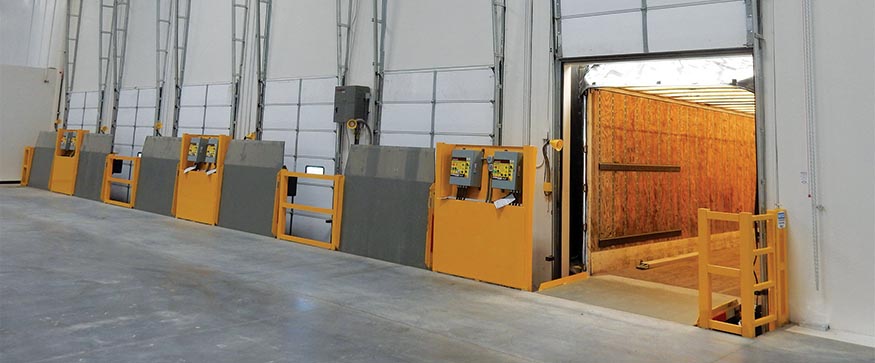
Interlocks ensure dock equipment is used optimally, which increases safety, security and efficiency.
“If everything is adequately and clearly labeled in such a way that with a single scan can capture all information about the product, dock operations will be more efficient,” Wheeler says. “Supplier management is always something that can be done better.”
The GS1 bar code standard is a key tool toward the goal of improved supplier management and dock efficiency. By standardizing the way virtually any data field is encoded, these labels enable the quick exchange of critical information, like lot, expiration date, country of origin, catch weight and more.
“In the past, if you wanted to do supplier management, it used to involve creation of elaborate routing guides,” Wheeler says. “You’d present the supplier with the specs for a label and all relevant data fields, and in some environments this makes sense, but for many others it’s a very onerous set of requirements to put on your supplier.”
With standardized labeling in place, it then falls to dock hardware and software to effectively capture the labels’ data. Whether a linear code or multiple bar codes, a scanner paired with the right software can read multiple codes in one scan. Rugged headland devices are common in the receiving and sorting of inbound goods for putaway. It’s a workflow that has a lot of variability, Wheeler says, including damaged or noncompliant product, and is often the one area where warehouse management system (WMS) transactions aren’t always repetitive.
Handhelds with plenty of screen real estate offer the option to present more data and communicate more clearly to dock attendants, who might like to call up an item master or other order information on the fly. These devices might also be equipped with extended range scanning or a camera to document damaged product and file a claim right on the device. The majority of operations do some label printing for putaway, using a range of stationary or mobile tabletop printers, or wearable printers.
For lift truck operators, purpose-built, vehicle-mounted devices are usually the most productive and operationally safe form factor. If work requires the operator to dismount, handhelds are a good choice. As handheld screens get larger, they become more viable for lift truck use, Wheeler says.
A third option is a rugged tablet, which can be mounted or removed from the lift truck to provide the best of both worlds. The tablet can then be tied to an extended range scanner when on the truck, or use an integrated medium-range scanner when walking.
Wheeler estimates more than 90% of dock processes rely on bar codes to identify and control the movement of inventory. There is some growth in passive or active RFID to track trailer locations, he says, but more and more carriers are using geo-fencing.
Geo-fencing is a process by which a trailer’s location can trigger alerts so that, for example, as soon as it crosses a certain threshold in the yard, people and systems inside the building can know how to prioritize and prepare accordingly. In private fleets, Wheeler predicts trailer-mounted sensor technology like passive and active UHF or low-energy Bluetooth will increasingly serve as beacons to ensure workers are loading the right materials in the right trailer.
The dock of the near future will also be defined by more detailed and comprehensive data capture, Wheeler says. He describes a current product offering consisting of an appliance affixed inside the dock to look into the trailer, whether inbound or outbound. Using video, 3D sensors and analytics, the solution collects and relays data to dock managers or transportation managers, presenting them with real-time metrics of what’s being loaded and unloaded.
“This is a part of the process that hasn’t been monitored before,” Wheeler says. “Previously, the only way was to walk the dock and watch how the work is being done. It was anecdotal and laborious to track.”
E-commerce is driving the need for granular dock data, as more enterprises need to ship direct to customers who assume same-day delivery and visibility into an order’s status and execution.
“There are lots of service commitments they have never faced before,” Wheeler says. “Ten years ago, when they designed the WMS, the facility and the docks, they were designing
to a different service commitment. Now it’s about operating faster and with perfection.”
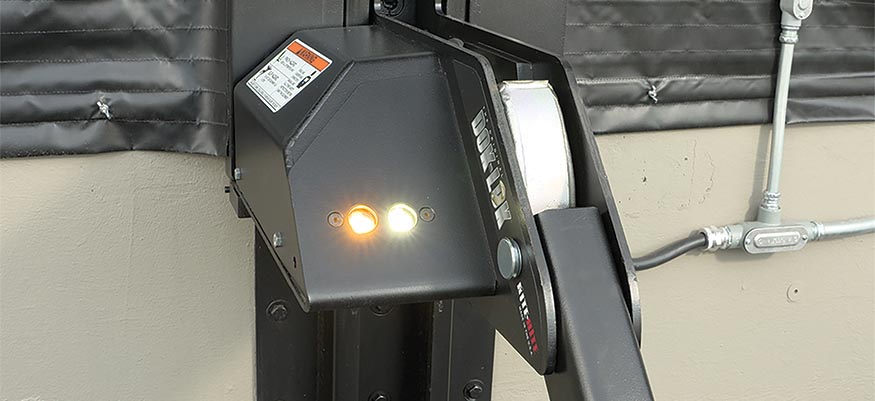
Visual and audible signals on the outside of a building can help alert pedestrians to reversing trailers.
Teach an old dock new tricks
As a 22-year industry veteran, Jeff Schulze, vice president of national account sales for Systems Inc., has witnessed the dock evolve from “just a hole in the back of the facility” to something that adds value to the company.
“It’s now a more thought-out, integral part of the operation,” he says. “It used to be that ‘buying in bulk’ meant storing a bunch of pallets on the dock until they were used up. That transitioned to buying just enough stuff, and the dock moved from being just a fixture to being integral to the process. Now it’s a money-making part of the facility.”
Or at least, it can be. Schulze recognizes that thousands of aspiring operations have been saddled with docks that were not designed with such lofty goals in mind. One thing that hasn’t changed over time is the need for reliability, and when a lean operation loses the use of even one dock door, the impacts can be painful.
As a result, providers of dock equipment and solutions have adapted their offerings to meet the needs of those facilities that would rather not tear down one side of the building and start over.
Electricity can power the newest push-button levelers, but running electricity to a manually operated dock is not always ideal. Wet or washdown environments, construction costs and obstacles, or sustainability objectives might prevent an upgrade to electric levelers. However, compressed air-powered levelers are now an option, providing the ease of push-button operation and safety interlocks while piggybacking on an existing or dedicated air compressor.
Schulze suggests the most difficult element to update is bad habits. The issue is particularly pronounced in less-than-truckload (LTL) deliveries, where small and quick movements of goods lead some to skip important safety steps at the dock. In fact, when interlocked equipment is installed, some customers even receive complaints from drivers who are compelled to engage every item of dock equipment.
“Some think those extra 10 or 20 seconds seem unnecessary, but that’s where most accidents happen,” Schulze says. “When you unload a full truck you have to make sure it’s empty, and the driver is in less of a hurry than LTL, where the driver might assume the one small bit of work is done and drive away too soon.”
The only way to bypass interlocks, Schulze says, is with a key or code typically entrusted only to the manager.
“You want to ensure people use the safety features you are providing for them,” Schulze adds, “even if they don’t want to.”
View Dock Equipment Products and Accessories
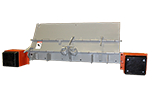 NL Series Dock Levelers
NL Series Dock Levelers
The DLM “NL” Series Edge-of-Dock is the state of the art in lever-operated dock levelers. Simply move the lifting lever 50° away from dock edge, and then return the lever to its original vertical position.
![]() Dock levelers for all applications
Dock levelers for all applications
Standard and special size hydraulic and manual levelers provide the solutions for new and old building construction. A wide variety of new dock levelers are available to meet your requirements.
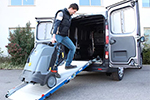 WM System Loading Ramps
WM System Loading Ramps
The Light series is a simple and economic loading ramp. Equipped with standard features including our industry leading spring assist and wheels on the end of the ramp for effortless deployment and storage.
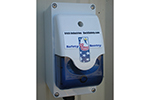 Safety Sentry dock warning signal alarm
Safety Sentry dock warning signal alarm
The SH15 Blackline computer is a rugged vehicle mounted computer (VMC) as well as a fixed mount unit. The SH21 Blackline computer is an industrial computer designed for a wall or fixed mount environments.
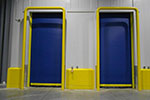 Turbo-Seal SR Dock Door
Turbo-Seal SR Dock Door
With an average speed of over 101 inches per second and an extraordinary insulating capacity, the Turbo-Seal Insulated door is the definitive solution for cold storage environments.
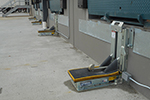 Stop-Tite® Push Button Vehicle Restraint
Stop-Tite® Push Button Vehicle Restraint
It comes equiped with a RIG sensor bar that notifies dock workers with an audible alarm if the restraint’s arm is not securely engaged with the trailer’s Rear Impact Guard.
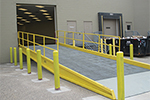 New portable steel yard ramp
New portable steel yard ramp
Allowing traffic to move from dock level to the ground or from the ground onto the back of a truck, a new portable steel yard ramp by DLM supports smooth flow of loading and unloading.
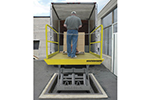 Dura-Dock loading-dock lifts
Dura-Dock loading-dock lifts
The lifts feature corrosion-resistant, galvanized base and legs standard; galvanized construction can be optionally specified for models up to 20,000 pounds. Usually mounted in a concrete pit, a drain in the base prevents standing water. Platform sizes range from 6 x 8 feet to 8 x 12 feet.
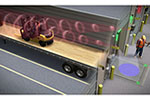 Pedestrian-Vu and Approach-Vu
Pedestrian-Vu and Approach-Vu
Pedestrian-Vu uses motion sensing technology to trigger a bright blue light that projects onto the dock leveler when it detects materials handling equipment or a pedestrian’s presence inside the trailer.
Companies mentioned in this article:

Article Topics
Equipment Report News & Resources
Radial stays ahead of the automation curve Wireless Mobility: Ready for the next leg up AGVs set new standards for inventory transportation Inside North Shore Care Supply: Bringing robots to receiving Bergen Logistics: Putting robots to work in a multi-tenant facility High-tech meets low-tech: Automate storage for pallet loads Tuggers, carts work together to increase productivity and ergonomics More Equipment ReportLatest in Materials Handling
Hyster recognizes Dealers of Distinction for 2023 Carolina Handling names Joe Perkins as COO C-suite Interview with Keith Moore, CEO, AutoScheduler.AI: MODEX was a meeting place for innovation Walmart deploying autonomous lift trucks at four of its high-tech DCs Coles shops big for automation Kathleen Phelps to join FORTNA as chief financial officer Coles automates grocery distribution in Australia More Materials HandlingAbout the Author
Subscribe to Materials Handling Magazine

Find out what the world's most innovative companies are doing to improve productivity in their plants and distribution centers.
Start your FREE subscription today.
April 2024 Modern Materials Handling

Latest Resources


